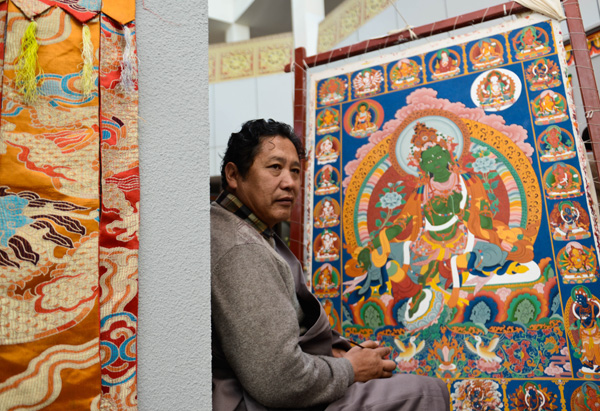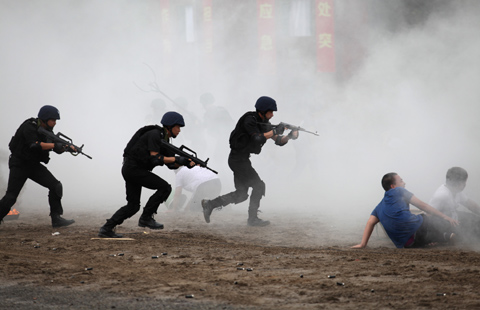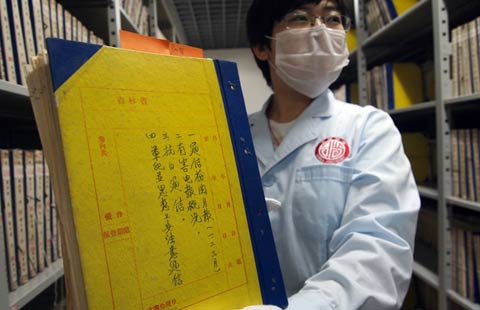Culture vultures swoop across the plateau
By Hu Yongqi and Da Qiong (China Daily) Updated: 2014-06-27 08:09
|
 Thangka painting is an important part of Tibet's intangible culture. [Photo/Xinhua] |
"Chentse-style Thangka has been influenced by both Nepali and Han culture," he said. "It means a lot for ethnic unity nationwide, and artists from both groups can interact to discuss techniques and artistic connections."
According to Ji Ji, director of the Intangible Cultural Heritage Office of the culture department, the annual subsidy available to a national-level inheritor was raised to 10,000 yuan from 8,000 yuan in 2012, and the subsidy for local-level inheritors rose by 60 percent to 5,000 yuan per annum.
Opera 'rock stars'
In 2009, Tibetan opera, an ancient art form that developed over many centuries, was added to UNESCO's Representative List of the Intangible Cultural Heritage. Performances combine folk dancing, singing and vocal dynamics. Hailed by cultural experts as a "living example of traditional Tibetan culture", the opera boasts a history of more than 600 years - about 400 years longer than China's national treasure, the Peking Opera.
In the past five years, the regional government has subsidized about 120 Tibetan opera troupes. Annual opera competitions are held to counter the decline in popularity of the form among young people, many of whom are losing touch with traditional culture because they live and work in other parts of China.
"Our department publishes the rankings, and the county officials see it as a way of enriching the local people's lives. County governments are encouraged to help the performers by providing funds to buy costumes and pay for rehearsal spaces. Hopefully, that will result in Tibetan opera attracting more local support," said Ji.
The department has also decreed that one-third of each troupe must be composed of performers younger than 40, according to Ji. "If not, we don't allow the troupe to participate in the contest. In this way, we hope young people will learn, and take leading roles in the future," she said, adding that the department has sponsored 32 training centers for local art forms and has provided a fund of 2 million yuan to refurbish living quarters and rehearsal facilities.
Ngawang Tenzin, deputy chief of the Center for the Protection of Intangible Cultural Heritage in Lhasa, said traditional art forms are being preserved to allow the younger generation to understand more about the cultures their ancestors created and preserved for hundreds of years.
He said the center hosts cultural exhibitions, featuring ethnic costumes, makeup and dancing, every day. In addition, the center arranges performances at schools, and selects talented students to study opera, dance and other local art forms.
Fans of the form treat the performers like rock stars. On May 21, Yang and his troupe visited Qamdo No 1 Middle School. The male dancers accessorized their costumes with knives, while the women wore elaborate jewelry. After carefully applying their makeup for two hours, the dancers appeared on a makeshift stage erected on the school's soccer field.
More than 600 students sat on the lawn and cheered. About 15 minutes after the performance began, classes ended and even more students rushed to the field.
No one spoke. Everyone watched Yang and his colleagues patiently. Some of the students had brought milk and snacks, but ate and drank in silence. When the show was over, the performers were given a standing ovation, and some students lingered to ask Yang for his autograph, which he duly wrote on their uniforms.
"Yang is a celebrity in Qamdo, and we are so happy to see him in person, instead on TV," said 15-year-old Sonam. "If possible, I hope he will come and perform for us every semester."
Contact the authors at huyongqi@chinadaily.com.cn and daqiong@chinadaily.com.cn
Palden Nyima contributed to this story.
- Courts in China to look out for lawyers
- China to accelerate development of insurance sector
- Electric-car buyers to get
tax exemption - China's progress on health reform 'remarkable'
- China's next kungfu masters
- Mermaids splash coolness to Nanjing summer
- Li: Govt will boost input for healthcare
- Colleges to retest athletes who got gaokao bonuses
- Top court to raise judges' pay
- JV to pay maximum fine for polluting air







